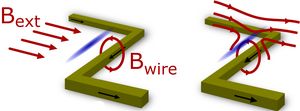Atom chip
An atom chip is mainly used in experimental atom optics. There it is used to store and manipulate atoms and atomic clouds in miniaturized magnetic traps. Atom chips arose from the desire to generate strong magnetic field gradients and complex magnetic potentials with manageable effort. Systems for the detection of atoms, such as resonators or optical fibers, can also be integrated directly on the atom chip. In many cases, atom chips are used to produce and examine Bose-Einstein condensates (BEC).
The basic idea of an atom chip is that high magnetic fields and magnetic field gradients can be generated in the immediate vicinity of the atomic cloud even with low currents, which allow atoms to be trapped in a controlled manner. Techniques from microfabrication allow great flexibility in the arrangement of the conductor tracks, so that complex trap shapes are possible that are difficult or impossible to implement with distant, macroscopic magnetic coils.
construction
The simplest structure of an atom chip consists of a single, current-carrying conductor, which runs perpendicular to a homogeneous magnetic field (which is generated, for example, by Helmholtz coils ). In a straight line parallel to the conductor track, the magnetic fields of the conductor and the homogeneous field cancel each other out. As a first approximation, the potential corresponds to a two-dimensional quadrupole field.
A little more complex are U- and Z-conductor configurations, in which the conductor initially runs parallel to the homogeneous magnetic field, then bends perpendicularly (which creates the 2d quadrupole field described above), then turns a little further perpendicular to parallel (Z- Configuration) or antiparallel (U configuration) to go to the first section. In the Z-configuration, an 'offset' field is generated through the sides of the conductor parallel to the direction of the central conductor part, which prevents magnetic zero crossings. In the U-configuration, the side tracks create a magnetic field gradient along the central conductor, whereby the entire magnetic field adds up to a 3D quadrupole field.
Due to the 1 / r relationship between the strength of the current in a conductor and the magnetic field produced by it, magnetic fields and gradients of almost any strength can be achieved if the distance is only reduced far enough. In reality, of course, the finite expansion of the atomic cloud and the conductor must be taken into account, which then limit the magnetic field. Nevertheless, relatively large fields can be generated with an atom chip, which are sufficient, for example, to restrict the movement of the atoms to one spatial dimension.
Atom chip development is fast-moving, and a number of different implementations are in use in research centers around the world. Examples are magnetic “conveyor belts” for atoms and radio frequency fields to generate special potentials. Traps made of permanent magnetic coatings instead of conductor tracks are also possible.
literature
- Jakob Reichel: Atom Chips. Conveyor belts for quantum clouds . In: Spectrum of Science (08/2005), p. 76 ff.
